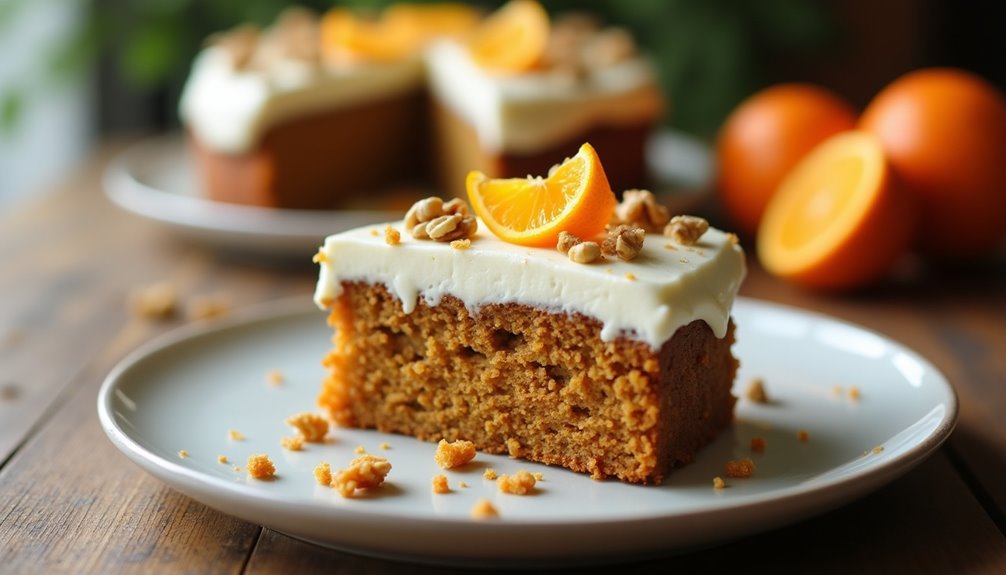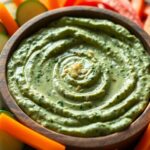You can create a delightful gluten-free carrot cake that's both moist and flavorful. Start by using a blend of almond and coconut flour for the perfect texture. Incorporate grated carrots, crushed pineapple, and spices like cinnamon and nutmeg for that warm flavor. Make sure to blend your wet and dry ingredients well to avoid clumps, and consider adding applesauce for extra moisture. Frost with a simple cream cheese icing for an indulgent finish. This cake not only tastes amazing but also provides a chance to explore new ingredients and connect with others. Discover more tips to elevate your baking!
Key Takeaways
- Use a combination of almond flour and gluten-free all-purpose flour for a light, airy texture in your carrot cake.
- Incorporate ingredients like applesauce or crushed pineapple for added moisture and flavor in the cake.
- Grate carrots finely and remove excess moisture to prevent a soggy cake.
- Mix dry and wet ingredients separately to achieve the desired batter consistency before combining.
- Consider various frosting options, such as cream cheese or yogurt-based, for delicious decorations and serving enhancements.
Benefits of Gluten-Free Baking
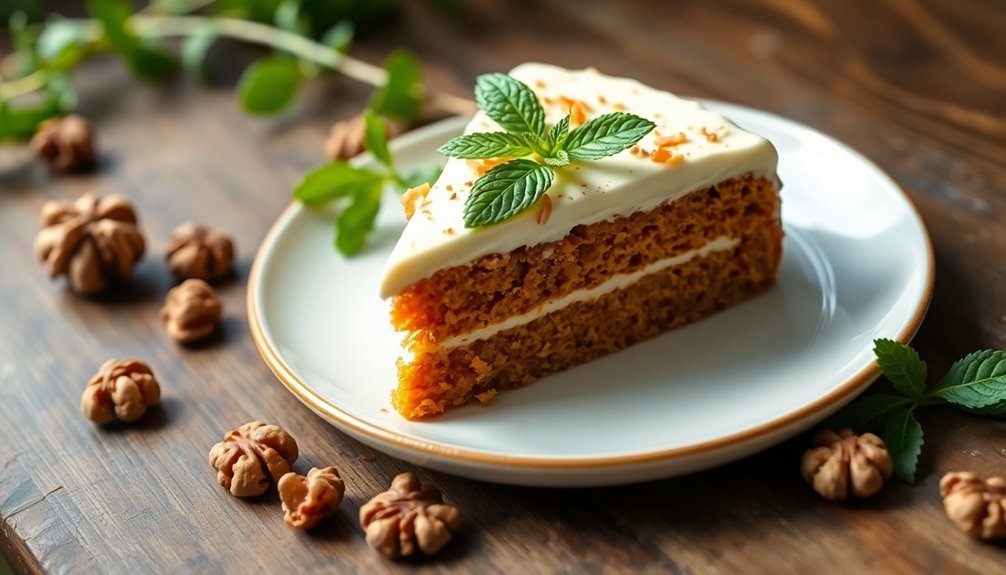
When you choose gluten-free baking, you're accessing a world of benefits that can enhance not just your health, but also your culinary experience. Embracing a gluten-free lifestyle can lead to various health benefits, such as improved digestion and increased energy levels. By opting for gluten-free ingredients, you may find that your body feels lighter and more vibrant, allowing you to enjoy your favorite treats without the discomfort that gluten can sometimes cause.
Navigating your taste preferences becomes a delightful adventure as you explore new flavors and textures. You'll discover that gluten-free baking isn't just about avoiding wheat; it's about embracing a variety of ingredients. You can experiment with almond flour, coconut flour, or even oats, each bringing its unique taste and nutritional profile to your creations.
Ingredient substitutions and recipe adaptations will become second nature. You might swap traditional flour for a gluten-free blend, or use applesauce in place of eggs to create a moist carrot cake. These adjustments not only cater to your dietary needs but also open doors to creativity in the kitchen.
As you dive deeper into gluten-free baking, you'll likely find a supportive community of fellow bakers who share your passion for delicious, inclusive treats. So, whether you're serving friends or enjoying a slice yourself, you'll feel a sense of belonging and satisfaction knowing you're making choices that align with your health and taste preferences. Embrace the journey, and let your gluten-free baking adventure begin!
Key Ingredients for Success
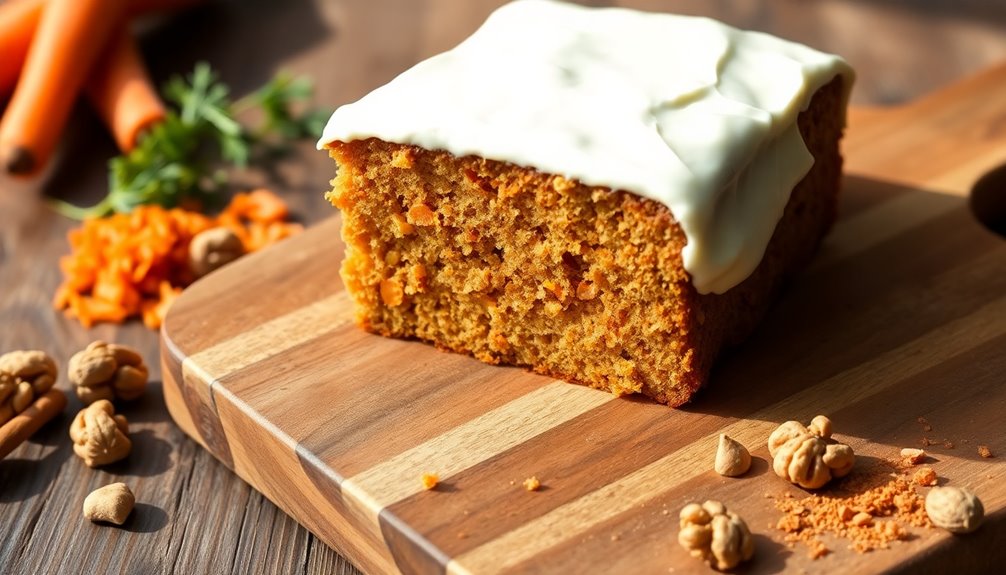
To create a delicious gluten-free carrot cake, knowing the right ingredients is key. You'll want to focus on a few essentials that bring both taste and texture to your baking.
Carrots, of course, are a must—they add natural sweetness and moisture. But don't stop there! Consider incorporating crushed pineapple or applesauce for an extra layer of flavor and a tender crumb.
When it comes to spices, cinnamon and nutmeg work wonders together, creating that cozy, warm flavor combination we all love. For those who enjoy a bit of crunch, adding chopped nuts or shredded coconut can elevate your cake's texture.
Don't forget to think about your texture preferences; if you like a denser cake, you might opt for almond flour or a blend of different gluten-free flours.
Ingredient substitutions can be your best friend. If you're dairy-free, swap out regular milk for almond or oat milk. For oil, you can use melted coconut oil or even a fruit puree for a healthier twist.
When you master these baking techniques and get comfortable with ingredient swaps, you'll find that gluten-free baking is accessible and enjoyable.
Choosing the Right Flour
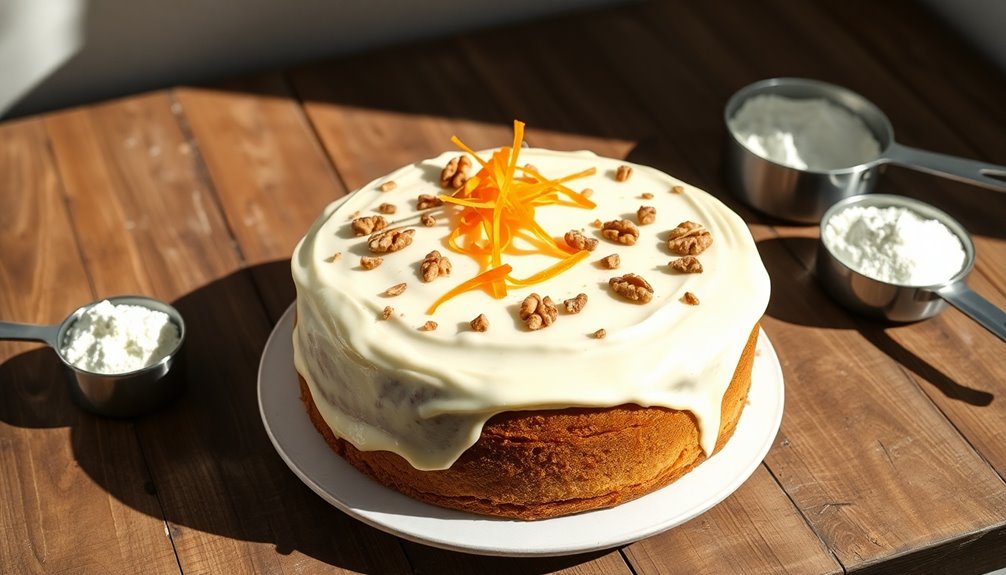
Choosing the right flour is essential for achieving the perfect gluten-free carrot cake. With so many flour alternatives available, you can create a cake that's not just gluten-free but also delicious and satisfying to your taste buds.
Whether you're baking for yourself or sharing with friends and family, selecting the right flour can make all the difference in your cake's flavor and texture.
If you prefer a light, airy cake, almond flour is a fantastic option. It adds moisture and a subtle nuttiness that complements the sweetness of the carrots.
On the other hand, if you're after a denser, more traditional cake texture, consider using coconut flour. Just remember, it absorbs a lot of moisture, so you'll need to adjust your liquid ingredients accordingly.
For those who enjoy experimenting, a blend of different flours can help you meet your texture preferences. Mixing brown rice flour with tapioca or arrowroot flour can create a balanced texture that holds together beautifully while still being light.
You can even try gluten-free all-purpose flour blends, which often contain a mix of these alternatives designed to mimic traditional wheat flour.
Ultimately, choosing the right flour alternatives comes down to your personal taste and the specific texture you're after. By exploring different options, you'll not only find the perfect combination for your carrot cake but also feel a sense of belonging in the gluten-free baking community, where everyone shares the joy of creating delicious treats.
Preparing Your Carrots
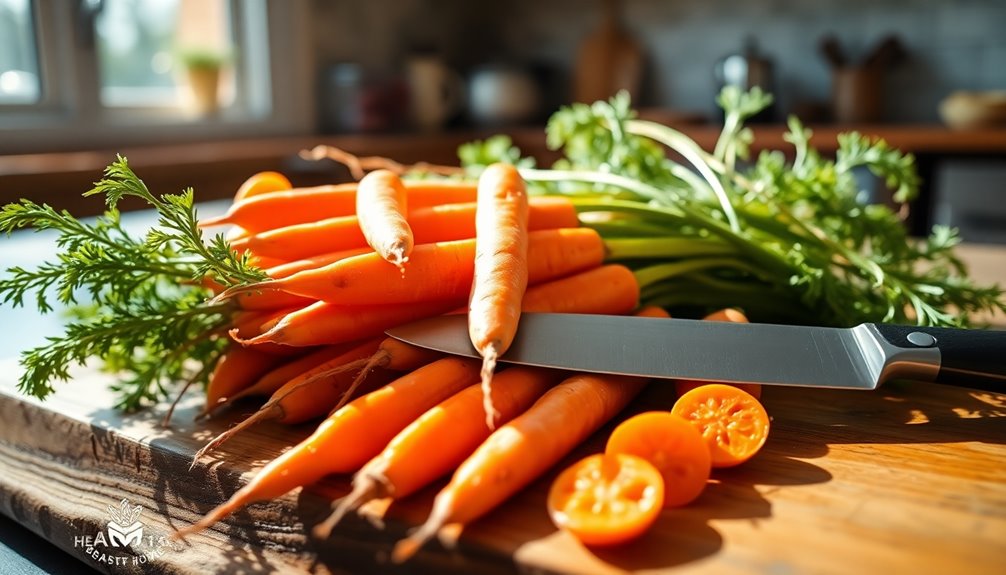
Often ignored, preparing your carrots properly is essential to a moist and flavorful gluten-free carrot cake. The way you handle your carrots can significantly impact the moisture levels in your final cake, so let's delve into the best practices.
First, consider whether you want to use organic or traditional carrots. Organic carrots often have a richer flavor and can add a special touch to your cake. However, traditional carrots are perfectly fine too, especially if you wash and peel them well.
When it comes to grating techniques, you've got a couple of options. A box grater works well for most, but a food processor can save time and effort. Regardless of your choice, aim for finely grated carrots. This helps them blend seamlessly into the batter, ensuring a uniform texture throughout your cake.
Don't forget to squeeze out any excess moisture after grating. Place the grated carrots in a clean kitchen towel, twist it, and apply pressure to remove the liquid. This step is essential because too much moisture can lead to a soggy cake.
Mixing the Batter
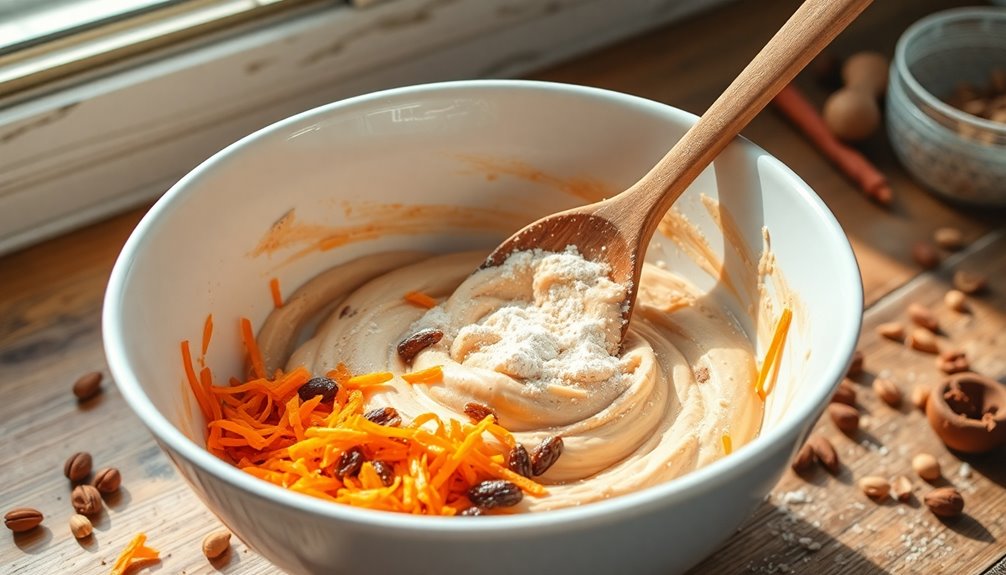
Mixing the batter for your gluten-free carrot cake is where all your hard work with the carrots starts to come together. You'll want to gather your ingredients and use effective mixing techniques to [CONFIRM] a delightful batter texture. Begin by combining your dry ingredients, like gluten-free flour, baking powder, and spices, in one bowl. In another bowl, mix the wet ingredients, including eggs, oil, and vanilla. This separation allows for better ingredient incorporation.
Once you've prepared both mixtures, it's time to combine them. Gradually add the dry mixture to the wet mixture, stirring gently. You're aiming for a smooth consistency, so keep a close eye on the batter. A consistency check is essential here; it should be thick but pourable. If it feels too dry, add a splash of milk or water to adjust.
To help you visualize, consider this table:
| Ingredient | Amount |
|---|---|
| Gluten-Free Flour | 2 cups |
| Grated Carrots | 2 cups |
| Eggs | 3 large |
| Sugar | 1 cup |
As you mix, feel the batter come alive under your hands. The scent of carrots and spices fills the air, creating a sense of warmth and belonging. Once you achieve that perfect texture, you're ready to pour your creation into the cake pan, knowing you're one step closer to sharing your delicious gluten-free carrot cake with loved ones.
Baking Tips and Tricks
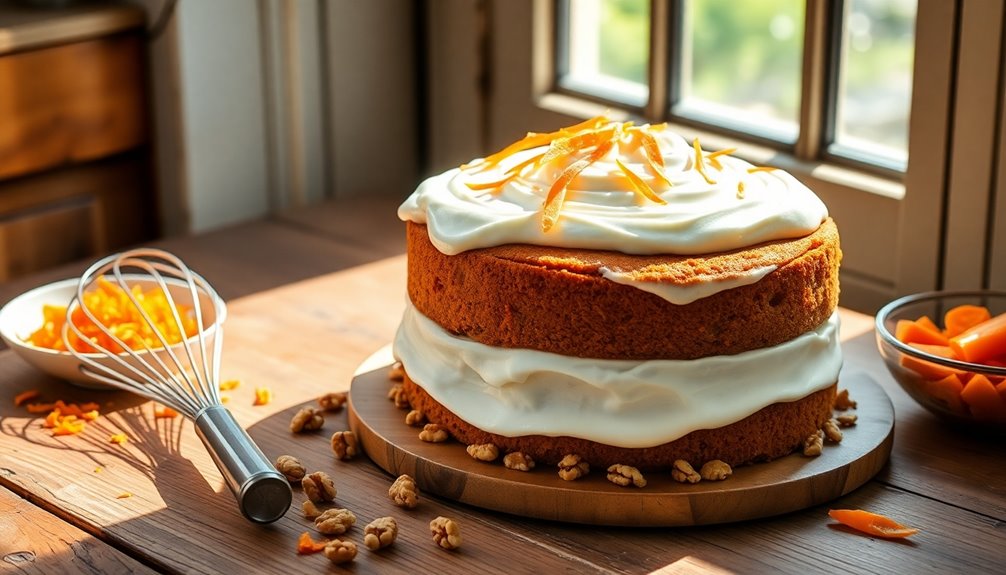
When it comes to baking your gluten-free carrot cake, a few key tips can make all the difference.
First, don't hesitate to explore baking substitutions that can enhance your cake's texture and flavor. For instance, using almond flour or coconut flour as ingredient alternatives can yield a moist result that rivals traditional recipes. You can also mix in applesauce or yogurt for added moisture.
Consider flavor combinations that elevate your cake. A sprinkle of cinnamon or nutmeg can bring warmth, while adding raisins or walnuts gives a delightful crunch. Just remember, too many add-ins can affect the cake's structure, so find that perfect balance.
If you encounter any hiccups during the baking process, keep these troubleshooting tips in mind. If your cake sinks in the middle, it might be due to excess moisture or not enough leavening agent. Make sure to measure your ingredients accurately and use fresh baking powder for the best rise. If the cake turns out too dense, try adding an extra egg or increasing the baking time slightly.
Lastly, don't forget to share your experiences with friends or family; they might've their own tips to contribute! By embracing these baking tips and tricks, you'll not only create a delicious gluten-free carrot cake but also foster a sense of community as you share this delightful treat with others. Happy baking!
Delicious Frosting Options
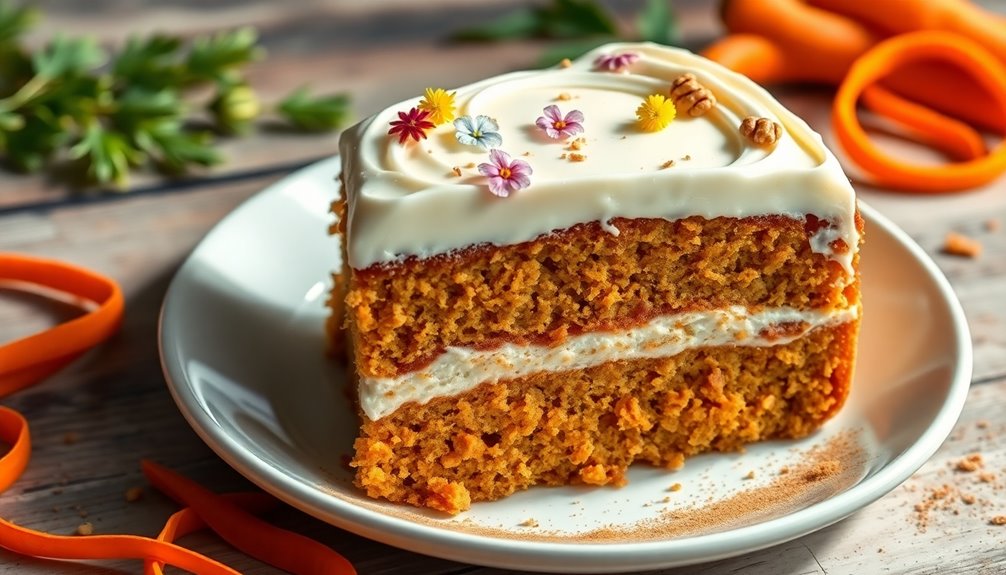
Choosing the right frosting for your gluten-free carrot cake can elevate its flavor and presentation. You've put in the effort to create a moist, spiced cake, so let's make sure the frosting complements it perfectly.
One of the most popular choices is classic cream cheese frosting. Its tangy sweetness pairs wonderfully with the carrot and spices, creating a harmonious blend that's hard to resist. You can whip up a simple frosting using cream cheese, butter, powdered sugar, and a splash of vanilla extract.
But if you're looking for something a bit different, consider vegan options! You don't have to miss out on delicious frosting just because you're avoiding dairy. A vegan cream cheese frosting can be just as delightful, using plant-based cream cheese and coconut or almond milk to achieve that creamy texture. You can also experiment with coconut whipped cream for a lighter, fluffier finish while still being vegan-friendly.
Another fun option is using a maple pecan frosting. Combine maple syrup, vegan butter, and crushed pecans to add a unique flavor that enhances the natural sweetness of your cake.
No matter which frosting you choose, make sure it reflects your style and taste. The right frosting can transform your carrot cake into a showstopper, inviting everyone to gather around and enjoy a slice together. So go ahead, get creative, and make your cake truly special!
Decorating Your Cake
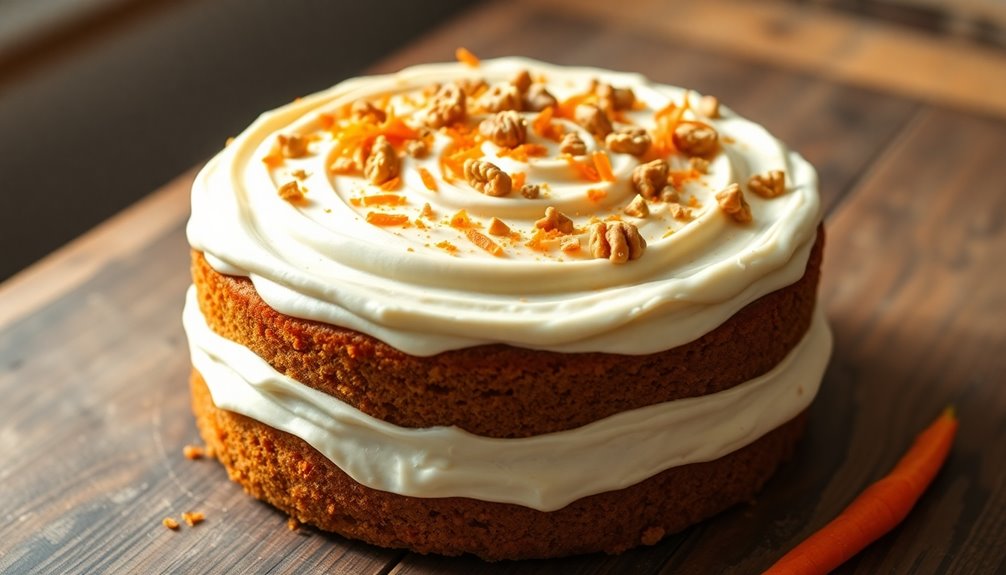
Transform your gluten-free carrot cake into a visual masterpiece with thoughtful decoration. The way you decorate your cake can make it not just a treat for the taste buds, but a feast for the eyes as well. Start by applying a luscious layer of frosting, then let your creativity shine through with some creative designs. You might consider swirling the frosting or using a spatula to create beautiful peaks. Don't shy away from experimenting—this is your chance to express yourself!
Next, it's all about those colorful toppings. Chopped nuts, shredded coconut, or even edible flowers can add a delightful pop of color and texture. You could also sprinkle a hint of cinnamon or nutmeg on top for an aromatic touch.
If you want to keep it fun, add some playful elements like chocolate shavings or vibrant fruit slices.
To truly make your cake stand out, think about a theme that resonates with you and your loved ones. Whether it's a rustic, homey vibe or a sleek, modern look, let your decorations reflect the joy of the occasion.
Gather your friends and family around as you showcase your creation, making it a centerpiece that invites everyone to celebrate and indulge together. Remember, the goal is to create not just a cake, but an experience that brings people together.
Storing Leftovers Properly
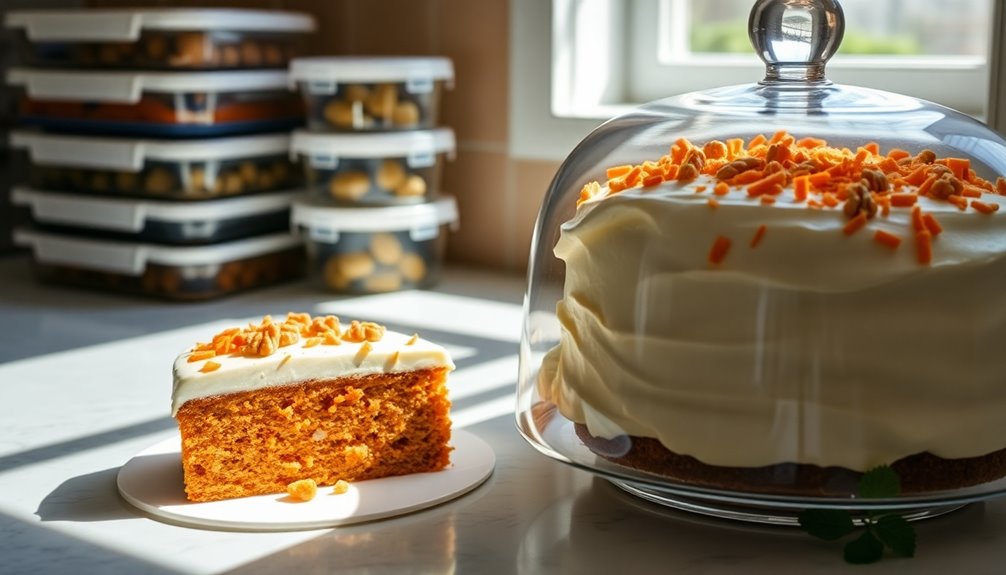
After enjoying your beautifully decorated gluten-free carrot cake, you'll want to make sure any leftovers are stored properly to maintain their freshness. The last thing you want is for your delicious creation to go stale or lose its charm. Follow these simple tips to keep your cake tasting as good as the first slice.
- Cool it down: Allow your cake to cool completely before storing it. This prevents condensation from forming, which can make it soggy.
- Wrap it well: Use plastic wrap or aluminum foil to tightly cover the cake. If you have a cake container, that works great too!
- Store at room temperature: For short-term storage, keep your cake at room temperature in a cool, dry place. It'll stay fresh for about three days.
- Freezing slices: If you want to save some for later, consider freezing slices. Just wrap each slice individually in plastic wrap and place them in an airtight container. You can enjoy them for up to three months!
- Thaw properly: When you're ready to indulge again, let the slices thaw in the fridge overnight, or at room temperature for a couple of hours.
Serving Suggestions and Pairings
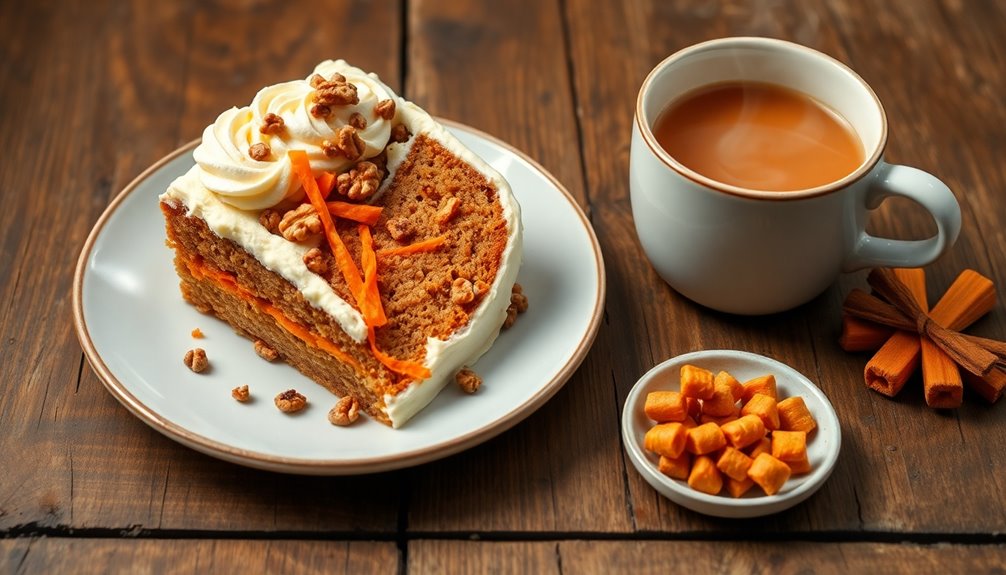
Elevate your gluten-free carrot cake experience by exploring delightful serving suggestions and pairings. Imagine gathering with friends, sharing warm laughter, and indulging in a slice of moist carrot cake that caters to everyone's tastes and dietary restrictions.
For a stunning presentation, consider topping your cake with a light cream cheese frosting, garnished with crushed walnuts or a sprinkle of cinnamon. The texture and flavors meld beautifully, creating a feast for both the eyes and palate.
Pairing your carrot cake with the right beverages can enhance the overall experience. Here are some ideas to inspire your next gathering:
| Flavor Combinations | Beverage Pairings | Dietary Considerations |
|---|---|---|
| Cream cheese frosting | Spiced chai latte | Vegan options available |
| Pineapple and coconut | Herbal mint tea | Dairy-free alternatives |
| Walnuts and raisins | Black coffee | Gluten-free choices only |
Feel free to mix and match these suggestions, ensuring everyone feels included. The warm spice of the cake complements the richness of a spiced chai, while the lightness of herbal tea balances the sweetness.
No matter how you serve it, your gluten-free carrot cake will undeniably bring people together. So, gather around, share stories, and enjoy each bite, knowing you've created a delightful moment for all.
Frequently Asked Questions
Can I Substitute Applesauce for Oil in This Recipe?
Sure, you can substitute applesauce for oil in your baking! It's a great swap that adds moisture while reducing fat. When considering applesauce vs. oil, remember that it may change the texture slightly, so you might need a bit more flour.
This swap also fits perfectly into vegan options, making your recipe more inclusive. Just keep these baking tips in mind, and you'll create something delicious everyone can enjoy!
How Can I Make This Cake Vegan-Friendly?
If you want to make your cake vegan-friendly, it's easier than you might think! Start by using egg replacers like flaxseed meal or applesauce to keep it moist.
For the frosting, consider vegan frosting alternatives like coconut cream or cashew frosting.
You'll create a delicious treat that everyone can enjoy! Remember, you're embracing a community that values compassion and creativity, and your cake will shine with those principles. Enjoy baking!
What Is the Best Way to Shred Carrots?
When you're looking to shred carrots, you've got a couple of great options.
A food processor can save you time, quickly turning those carrots into perfect shreds with minimal effort.
If you prefer a hands-on approach, a hand grater works wonders too—it gives you more control over the texture.
Both methods are fantastic kitchen gadgets that make the cooking process enjoyable, letting you showcase your skills and create delicious dishes everyone will love.
Can I Freeze Leftover Carrot Cake?
Yes, you can freeze leftover carrot cake! To do this, make sure it's completely cooled.
Wrap individual slices tightly in plastic wrap, then place them in an airtight container or freezer bag for extra protection.
For the best flavor, try to eat it within three months.
When you're ready to enjoy, just thaw it in the fridge overnight.
These freezing tips and storage suggestions will help you savor every bite later!
How Long Does Gluten-Free Carrot Cake Last in the Fridge?
When you store carrot cake in the fridge, it generally lasts about 5 to 7 days. To guarantee its shelf life and maintain quality, wrap it tightly in plastic wrap or place it in an airtight container. This preservation method will help keep it moist and flavorful.
If you notice any changes in texture or smell, it's best to discard it. Enjoy your cake while it's fresh for the best experience!
Conclusion
You've just created a delightful gluten-free carrot cake that's sure to brighten anyone's day. By embracing the art of gluten-free baking, you've turned simple ingredients into a masterpiece that speaks to the heart. As you savor each slice, remember that every bite is a sweet hug, a gentle reminder that everyone deserves a taste of joy, regardless of dietary choices. So, share your creation and let the smiles be your sweetest reward!

